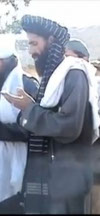A suicide assault team killed seven Afghans during an attack on a government compound in the eastern Afghan province of Paktika today. The Taliban claimed credit for the attack.
The three-man suicide assault team, which was armed with suicide vests, rocket launchers, and assault rifles, infiltrated the provincial center in Sharan, the capital of Paktika, and attacked the telecommunication center, the governor's office, and the headquarters of the National Directorate of Security. The Taliban fighters battled Afghan police and soldiers for six hours before all three were killed. Three policemen and four government workers were killed during the fighting.
Taliban spokesman Zahibullan Muhajid claimed credit on the terror group's website, Voice of Jihad, for the "martyr operation" in Paktika.
"Mujahideen of the Islamic Emirate, armed with explosive vests and heavy and small arms, stormed the department of telecommunication in the capital of Paktia province on Wednesday morning," the Taliban statement read. "After taking positions in the strategic points within the facility, began targeting the intelligence department, governor house and other government buildings."
The Taliban claimed that "a large number of the puppet soldiers officers and officials were killed and wounded."
Today's terror assault was likely carried out by the Haqqani Network, the Taliban subgroup that dominates operations in the southeastern provinces of Paktika, Paktia, and Khost.
|
Image may be NSFW. Clik here to view. 
|
| Image of Haqqani Network military commander Mullah Sangeen Zadran. Obtained by The Long War Journal from a Taliban propaganda tape. |
Paktika province serves as a safe haven for the Haqqani Network, a Taliban subgroup with close ties to al Qaeda. Paktika province is run by Mullah Sangeen Zadran, who is the shadow governor. Mullah Sangeen is a senior lieutenant to Siraj Haqqani, the military commander of the Haqqani Network who serves on the top councils for al Qaeda and the Taliban.
Mullah Sangeen has been designated by the US as a global terrorist for his ties to al Qaeda and links to terrorist attacks. Sangeen has admitted his ties to al Qaeda. In September 2009, Sangeen granted an interview with As Sahab, al Qaeda's media arm, in which he stated: "Al Qaeda and the Taliban all are Muslims and we are united by the brotherhood of Islam. We do not see any difference between Taliban and al Qaeda, for we all belong to the religion of Islam. Sheikh Osama [bin Laden] has pledged allegiance to Amir al Mumineen [the Leader of the Faithful, Mullah Muhammad Omar] and has reassured his leadership again and again. There is no difference between us, for we are united by Islam and the Sharia governs us." Mullah Sangeen recently conducted an interview with Al Samood, the Taliban's magazine, and claimed that there is no difference between the Haqqani Network and the Taliban.
Al Qaeda and allied groups maintain a presence in Paktika province, according to an investigation by The Long War Journal. US military press releases document the presence of al Qaeda and "foreign fighter" cells in the districts of Bermel, Sar Rowzah, Wor Mamay, Yahya Khel, Yosuf Khel, Zadran, and Ziruk; or seven of Paktika's 18 districts.
Al Qaeda fighters are known to have been killed while fighting in Paktika. Most recently, in June 2011, al Qaeda announced the death of Mahmoud Hamdan Nizal, a Jordanian who was known as Abu Dher al Urduni. Nizal was killed while attacking Combat Outpost Margah, his martyrdom statement claimed.
Sources:
Suicide attackers storm office in Afghan east, 7 killed, Reuters
Taliban militants attacked NDS building in Paktika, Ariana News
Sores of puppets killed in martyr operation; heavy fighting ongoing, Voice of Jihad